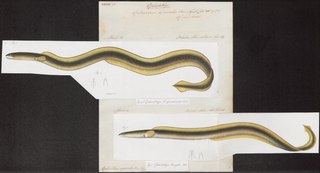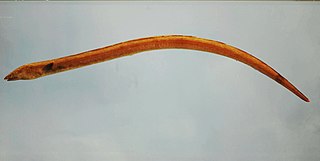
Ophichthus is a genus of eels in the snake eel family Ophichthidae.
The thin snake eel is an eel in the family Ophichthidae. It was described by John E. McCosker and Richard Heinrich Rosenblatt in 1998. It is a marine, tropical eel known from the eastern central and southeastern Pacific Ocean, including Mexico and Colombia. It is known from two specimens observed dwelling in sand at a depth range of 0 to 8 m. The maximum length recorded was 23.1 cm (9.1 in), albeit on an immature specimen.
The dark deepwater snake-eel is an eel in the family Ophichthidae. It was described by John E. McCosker and Chen Yu-Yun in 2000. It is a marine, deep water-dwelling eel which is known from Taiwan, in the northwestern Pacific Ocean. It dwells at a depth range of 36–1350 m, and inhabits sand and mud. Specimens have been observed in burrows with only their heads exposed, or resting on sediment with their bodies curved in an S shape. Females can reach a maximum total length of 62.8 cm.

The bluntnose snake-eel is an eel in the family Ophichthidae. The author of the species is anonymous, but it has been referred to Edward Turner Bennett in 1830. It is a tropical, marine eel which is known from the Indo-Pacific, including Kenya, Madagascar, South Africa, Taiwan, Thailand, and the Philippines. It dwells at a maximum depth of 22 m, but also frequents shores. Males can reach a maximum total length of 45 cm.
The snubnose snake eel is an eel in the family Ophichthidae. It was described by John E. McCosker and Steve W. Ross in 2007. It is a marine, subtropical eel which is known from North Carolina, USA, in the western central Atlantic Ocean. It dwells at a depth range of 370 to 440 metres. Females can reach a total length of 29.2 centimetres (11.5 in).

The dark-shouldered snake eel is an eel in the family Ophichthidae. It was described by Pieter Bleeker in 1864. It is a tropical, marine eel which is known from the Pacific Ocean, including the East Indies, the Society Islands, the Mariana Islands, Queensland, the Marshall Islands, Micronesia, Japan, and India. It dwells at a depth range of 2–15 metres, and inhabits reefs. It forms burrows in mud and sand, and forages during the night. Males can reach a maximum total length of 115 centimetres.
The Dusky snake eel is an eel in the family Ophichthidae. It was described by Camillo Ranzani in 1839. It is a tropical, marine eel which is known from the western Atlantic Ocean, including Cuba and Brazil.
The death-banded snake-eel is an eel in the family Ophichthidae. It was described by Samuel Garman in 1899. It is a tropical, marine eel which is known from the eastern central and southeastern Pacific Ocean, including the central Gulf of California, Colombia, Costa Rica, Mexico and Panama. It dwells at a depth range of 35–760 metres, and forms burrows in sandy and muddy bottoms. Males can reach a maximum total length of 86 centimetres.

The shrimp eel is an eel in the family Ophichthidae. It was described by Francis de Laporte de Castelnau in 1855. It is a common inshore species of eel usually found in the shallow Gulf of Mexico and the high-salinity bays where it inhabits muddy habitats.
The Faintsaddled snake eel is an eel in the family Ophichthidae. It was described by John E. McCosker and Eugenia Brandt Böhlke in 1984. It is a marine, temperate water-dwelling eel which is known from the western central Atlantic Ocean. It is known to dwell at a depth of 108 metres.

The Evermann's snake eel is an eel in the family Ophichthidae. It was described by David Starr Jordan and Robert Earl Richardson in 1908. It is a marine, tropical eel which is known from the western Pacific Ocean. It inhabits inshore soft bottoms.
The Shorthead snake-eel is an eel in the family Ophichthidae. It was described by Wilhelm Peters in 1855, originally under the genus Ophiurus. It is a marine, tropical eel which is known from the western Indian Ocean, including Aldabra and Mozambique. Its range was once reported to include Knysna, South Africa, but the specimen on which this claim was based has disappeared. Males can reach a maximum total length of 47 centimetres (19 in).
The Longarmed snake eel is an eel in the family Ophichthidae. It was described by John E. McCosker and Richard Heinrich Rosenblatt in 1998. It is a marine, tropical eel which is known from the eastern central Pacific Ocean, including Mexico, Costa Rica, El Salvador, Guatemala, Nicaragua, and Panama. It is known to dwell at a depth range of 24 to 79 metres, and inhabits soft substrates. Males can reach a maximum total length of 27.4 centimetres (10.8 in).
Ophichthus megalops is an eel in the family Ophichthidae. It was described by Hirotoshi Asano in 1987. It is a marine, temperate water-dwelling eel which is known from Japan, in the northwestern Pacific Ocean. It is known to dwell at a depth of 360 metres (1,180 ft). Males can reach a maximum total length of 33.2 centimetres (13.1 in).
Ophichthus melope is an eel in the family Ophichthidae. It was described by John E. McCosker and Richard Heinrich Rosenblatt in 1998. It is a marine, tropical eel which is known from the eastern central and southeastern Pacific Ocean, including Colombia and Costa Rica. It dwells at a depth range of 100 to 224 metres. Males can reach a maximum total length of 27 centimetres (11 in).
The dottedline snake eel is a species of eels in the family Ophichthidae. It was described by John E. McCosker and Eugenia Brandt Böhlke in 1984. It is a marine, temperate water-dwelling eel which is known from the western central Atlantic Ocean. It is known to dwell at a depth of 183 metres.
The many-eyed snake-eel is an eel in the family Ophichthidae. It was described by Pieter Bleeker in 1864. It is a tropical, marine and freshwater-dwelling eel which is known from the Indo-Pacific, including East Africa and the Hawaiian Islands. It dwells at a depth range of 2 to 25 metres, and inhabits sand and rubble sediments near coral reefs. Males can reach a maximum total length of 62.5 centimetres (24.6 in).

The Punctuated snake-eel is an eel in the family Ophichthidae. It was described by Achille Valenciennes in 1837, originally under the genus Ophisurus. It is a marine, subtropical eel which is known from the eastern central and southeastern Pacific Ocean, including Nicaragua, Chile, Colombia, Costa Rica, Ecuador, Peru, and Panama. It dwells at a depth range of 15 to 277 metres, and inhabits sand and mud sediments. Males can reach a maximum total length of 85 centimetres (33 in), but more commonly reach a TL of 60 centimetres (24 in).
The King snake eel is an eel in the family Ophichthidae. It was described by James Erwin Böhlke and John H. Caruso in 1980. It is a marine, tropical eel which is known from Florida to Texas, USA, in the northern Gulf of Mexico in the western Atlantic Ocean. It dwells at a depth range of 15 to 365 metres, and inhabits offshore waters. Males can reach a maximum total length of 211 centimetres (83 in); the maximum recorded weight is 23.6 kilograms (52 lb). caught by Patrick Lemire on the Texsun II out of Galveston, Texas in 1997.

The Manetail snake eel is an eel in the family Ophichthidae. It was described by Coenraad Jacob Temminck and Hermann Schlegel in 1846, originally under the genus Conger. It is a marine, tropical eel which is known from the Indo-Pacific. It inhabits deep waters, but is found in muddy sediments in shallow waters on rare occasions. Males can reach a maximum total length of 61.5 centimetres (24.2 in).







